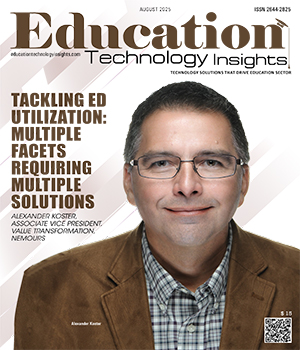THANK YOU FOR SUBSCRIBING
Be first to read the latest tech news, Industry Leader's Insights, and CIO interviews of medium and large enterprises exclusively from Education Technology Insights
Moving Beyond Reaction to Proactive Student Engagement
Rachel A. Beech, Ed.D., Vice President, Enrollment Management & Student Success, Miami University
 Rachel A. Beech, Ed.D., Vice President, Enrollment Management & Student Success, Miami University
Rachel A. Beech, Ed.D., Vice President, Enrollment Management & Student Success, Miami UniversityEvery fall, the conversation around student engagement begins with the same resigned statement: 'The students seem different this year.' This feeling of constantly playing catch-up in planning activities has led to a costly cycle of reaction rather than anticipation. Universities do not have the time to catch up to where students are; instead, practitioners need tools that help them better anticipate what is most likely to resonate and engage their student body from day one.
Many institutions speak to their comprehensive student experience in the materials that draw applications to the institutions. That expectation, reinforced by the traditional and social media consumed by prospective students, informs the individual’s decision to apply and their hopes for their time at the university. The ability for an institution to plan a campus life experience that reaches the right students at the right time can be a game-changer for retention, persistence, and graduation success.
When students are engaged—meaning they feel seen, challenged, and connected to the campus community—they develop a powerful sense of belonging and affinity. This connection transforms the university from a transactional provider of education into a supportive and transformative environment. Students who feel invested in their institution are far more likely to persist through academic or personal difficulties, as they have established networks of peer and professional support to draw upon. Intentional engagement strategies serve as a crucial risk mitigation factor, significantly improving the odds that students will not only stay enrolled but also ultimately graduate.
How can an institution align its offerings with what students are looking for when they enroll? The data needed to build this proactive planning tool is not only available today, it’s already residing in your admissions and application systems.
“Intentional engagement strategies serve as a crucial risk mitigation factor, significantly improving the odds that students will not only stay enrolled but also ultimately graduate.”
As prospective enrollees submit their materials, they share data beyond their intended major. Most application systems also ask students to submit their co-curricular interests, typically through resumes, essays, or lists of clubs and work experience. It tells you how they chose to engage as leaders, team members, employees or in their families. This is rich data that provides a glimpse into what may draw their attention once they enroll, whether it is in research, social engagement, professional development, work opportunities, or the many other offerings your institution provides.
Yet, when institutions talk about admissions and enrollment data, it's the numbers that are most often prized. Institutions look at the quantitative data. How many and what increases in applications are we seeing? Are new markets opening up for us to explore for future enrollment? What is the yield rate of those who were admitted? What is the average GPA of those choosing our institution? By prioritizing these quantitative metrics, however, institutions often overlook the wealth of qualitative information that could be used to understand better what students want from their university experience.
The qualitative data found in most applications could be used to build a predictive model for engagement behavior. Students tell us about their extracurricular activities and the depth of their involvement in them, share their values and passions in their essays, and their academic goal tells us about their hopes for the future. With the assistance of AI, mining this qualitative data moves beyond simple keyword matching. The system can interpret behavioral indicators—such as dedication demonstrated through leadership roles, depth of commitment to research, or stated values in essays—to build a comprehensive, aggregate engagement profile of the new class. The profile can then be used to inform campus constituencies as they develop their activity and program plans for the academic year, allowing them to invest in areas that are most likely to align with student expectations and institutional identity and values.
The strategic deployment of this profile can yield immediate operational and financial advantages. As higher education institutions face increasing costs and limited resources, shifting planning from what the university has always done to what incoming students are most likely to value has practical and financial benefits for the institution. These profiles can help us match student interest to the activities offered, allowing us to align the best time, talents, and resources of our teams. Comparing the data gathered to the offerings at the institution will enable you to create a mission-centered roadmap that guides students to activities most likely to draw their interest, enabling them to build community and affinity and genuinely feel a part of your institution.
Identifying the unique profile of your class is not a one-time endeavor. As students enroll, adding actual curricular and co-curricular engagement data allows an institution to create a cycle of continuous improvement, ensuring that the resources committed to the student experience are aligned with individual needs, fostering true satisfaction and success. The goal isn't just to keep students enrolled, but to catalyze their passions and create graduates who embody the unique identity of the institution.
Read Also
Building an Understanding of AI in Learning Environments
Integrating SEL, Digital Citizenship, and AI Literacy in K–8 Schools
Preparing Students for More than their First Job
Moving Beyond Reaction to Proactive Student Engagement
Tech-Enabled, Human-Centered: Effective Student Support
Compassion That Shapes Student Success

I agree We use cookies on this website to enhance your user experience. By clicking any link on this page you are giving your consent for us to set cookies. More info

However, if you would like to share the information in this article, you may use the link below:
www.educationtechnologyinsightseurope.com/cxoinsights/rachel-a-beech-nid-3550.html






















